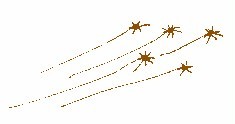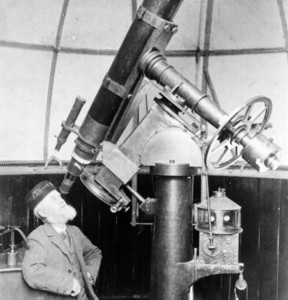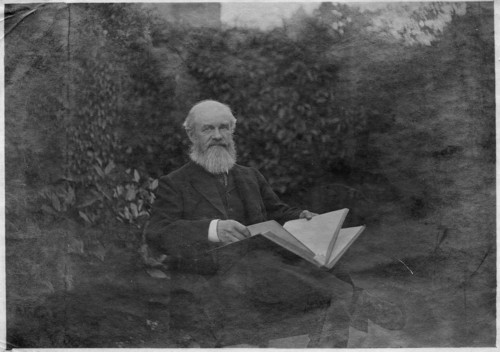

 |
|
Charles Grover at the telescope in the Rousdon observatory, c. 1907 |
Charles Grover was born in 1842 and was in many ways the archetypal Victorian amateur astronomer – not a 'Grand Amateur' – but a working-class astronomer, self-educated, self-made.
On his own in the world by the age of twelve, he was apprenticed to a brush-maker. Always, by his own account, an avid reader, his attention turned to astronomy after he saw Donati's comet in 1858, watching it night after night and tracing its path across the sky. He continued watching the sky and the next year noticed an occultation of Saturn. It was this that inspired his first astronomical purchase – an old ship's spy glass, which cost him 10 shillings, and with which he began to study the sky in earnest.
He made himself a telescope in 1861, and in 1863 purchased a Slugg telescope, which must have represented a huge outlay. He kept detailed notes of his observations, at the start of 1865 noting a bright spot on the moon. This he described in a letter to Revd T.W. Webb with whom he continued a correspondence for many years. It is one of a number of Charles Grover's observations included in Webb's Celestial Objects for Common Telescopes. Webb also facilitated Charles's contributing a series of articles to the Intellectual Observer and the Astronomical Register.
Charles Grover's observations of Saturn in 1862.
In 1865 Charles visited Dr John Lee at Hartwell House in Aylesbury. This was at the same time as William Birt was working there on the great (and never finished) lunar map. Charles Grover joined the band of amateur astronomers who corresponded with Birt and sent him information on their observations.
Dr Lee gave Charles some money and some books. In 1866 James Buckingham, who had an engineering works at Walworth Common gave Charles a 4-inch reflecting telescope, and in 1867 he received the gift of a 6 ½ -inch mirror from George With, which he set up with 'the kindly help of' the Revd Henry Cooper Key and George Knott. In 1869, instrument maker John Browning gave him 'a new plane mirror, Barlow lens & several achromatic eyepieces' and lent him a 4 ½-inch reflector. Best of all, he offered Charles a job, and in the same year he left brushmaking and moved to London.
As Browning's assistant he gained an unparalleled knowledge of amateur observatories around Britain, frequently travelling to help set instruments up, and making many friends in so doing. He rewrote a great deal, over the years, of Browning's A Plea for Reflectors, made working drawings of equipment for manufacture, tested instruments and packed them for despatch. With Browning he attended many of the meetings of the Royal Astronomical Society where they would demonstrate new equipment and where he came into contact with numerous well-known and highly-regarded astronomers. (In 1908 a dinner was held in Charles Grover's honour by the Royal Astronomical Society under the chairmanship of H.H. Turner, who was an admirer of Charles's work and visited him at Rousdon in Devon, and with an introduction to 'my very old friend Mr Grover' from E.B. Knobel.)
He met numerous other people through his work as a magic lantern operator at shows and talks in a variety of venues. He worked with, among many others, E.B. Knobel, R.A. Proctor and a Dr Carpenter, who lectured on the 'bed of the Atlantic and other ocean depths'. He also seems to have worked with Professor Pepper, whose famous illusion, 'Pepper's Ghost', never failed to please.
In 1882 Charles Grover left Browning's to go to Australia as assistant to Cuthbert Peek (whose father Sir Henry Peek was a baronet and a Member of Parliament), as part of a Royal Geographical Society expedition to observe the transit of Venus. After a voyage of 45 days, marked by frequent storms and haunted by fears of smallpox, they docked in Melbourne, continuing by sea to Sydney and on to Brisbane, then by train and wagon to Jimbour on the Darling Downs, in Queensland. Here the party, which also included Lieutenant Leonard Darwin, one of Charles Darwin's sons, set up their portable observatories and waited for the day of the transit of Venus to dawn.
Charles Grover's illustration of the observatory at Melbourne.
On his return to England in 1883, Charles Grover and his wife and son moved from London to a lodge house on the Peeks' estate at Rousdon in Devon. Here was constructed an observatory where (under Cuthbert Peek's auspices) Charles specialised in the observation of variable stars. In 1904 the annual observations (published in the Journal of the British Astronomical Association) for 1885-1900 were collected together, edited by H.H. Turner, and published by the Royal Astronomical Society.
The Astronomer of Rousdon tells the story of Charles Grover using much original documentation and a number of illustrations. As well as his astronomical adventures and his observations on Australia and Australian life, it describes something of his life as a member of a model community in the late nineteenth century.
The book also explores the possibility that Charles Grover was Thomas Hardy's contact after he approached the Greenwich Observatory for information regarding the construction of a small observatory as part of his preparation for writing his astronomical novel, Two on a Tower, and considers whether, to some degree, Charles Grover became the model for Hardy's creation, Swithin St Cleve.
 |
|
Charles Grover in the garden at Rousdon c. 1907 |